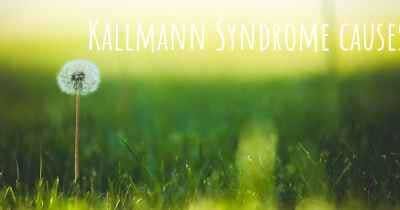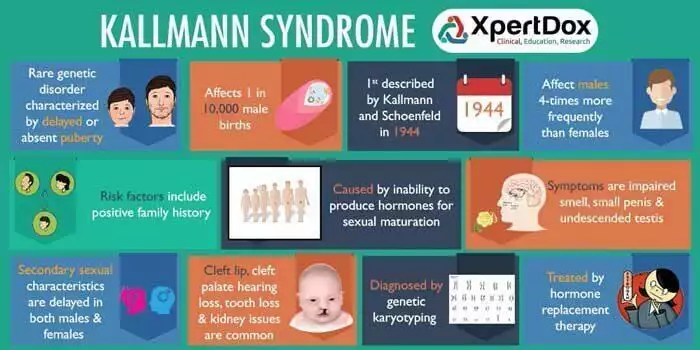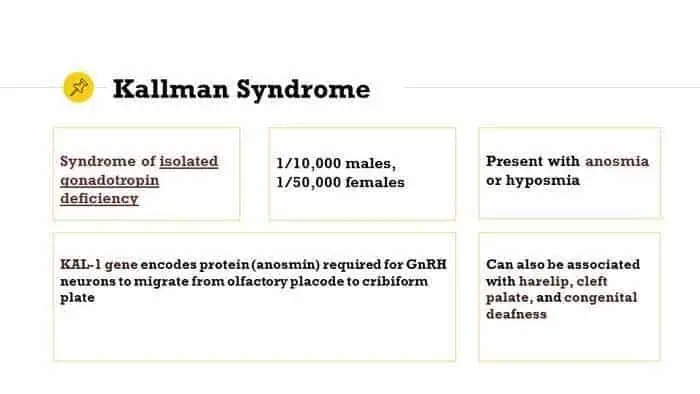This may be of interest to those of you who live with this disorder, and even those who don’t. We wanted to set the facts straight on what this disorder actually is. There is help out there and we want to make sure people know about it.
Kallmann syndrome is an inherited disorder that is characterized by the inability to start or complete puberty as a result of insufficient production of gonadotropin hormones. It is a rare disease that affects 1 child in every 10,000 births, although recent studies in Finland show the prevalence to be around 1 in 43,000.
What makes Kallmann syndrome different from other similar conditions, such as Turner syndrome or Klinefelter syndrome, is that it is accompanied by a lack of sense of smell or the decreased ability to smell.
Cause

Kallmann syndrome is caused by impairment of the hypothalamus to release gonadotropin-releasing hormone (GnRH), which is supposed to stimulate the anterior pituitary gland in releasing gonadotropin hormones. These hormones are known as luteinizing hormone (LH) and follicular stimulating hormone (FSH).
LH and FSH have a direct action on the testes and ovaries in men and women, respectively. Therefore, a disruption in the release of these hormones will initially delay the onset of puberty, which will lead to the inhibition in the development and functioning of the mentioned male and female sex organs. This will result in a reduced level of the sex hormones testosterone and estrogen in men and women, respectively, which will lead to reduced fertility in both.
Clinical presentation

The clinical picture can be divided into non-reproductive and reproductive signs and symptoms.
Not all patients diagnosed with Kallmann syndrome will experience all the signs and symptoms associated with the condition. These clinical presentations also occur in varying degrees amongst family members.
Non-reproductive signs and symptoms include:
- Lacking the ability to smell (anosmia) or reduced sense of smell (hyposmia).
- Decreased ability to hear.
- Craniofacial defects such as cleft palate.
- Missing teeth.
- Skeletal defects including a split foot or hand.
- Renal agenesis (a missing kidney).
- Osteoporosis that can develop as a complication.
Reproductive signs and symptoms include:
- Inability to start or complete puberty. If puberty hasn’t started by 14 years of age in females and 15 years of age in males, in the presence of non-reproductive signs, these patients then need to consult with a reproductive endocrinologist.
- Decreased testicular development in males of less than 4ml.
- Amenorrhea (no menstruation) in females.
- Difficulty in differentiating between males and females due to poorly defined secondary sexual characteristics, e.g., muscle and breast tissue development, hair distribution, etc.
- Decreased or no fertility.
Management
Hormone replacement therapy is the golden standard of treatment in the form of testosterone for men and estrogen for women. This is initiated when the diagnosis is confirmed and after optimal physical development has been completed, affected men will continue with testosterone replacement so that normal sexual functioning and energy levels are maintained. In women, a choice can be made regarding the different hormonal replacement medications available depending on whether they would like to start menstruating or not.
Fertility treatments are available for those who are experiencing issues with conception and involve the administration of gonadotropin hormones.

Challenges
Since Kallmann syndrome involves the delayed start or incompleteness of puberty, the psychological well-being of the affected teenager may be negatively impacted. In a time when social media is rife with information regarding how one should look and dress, dealing with a condition that delays the development of the patient is bound to draw unnecessary and inappropriate comments from peers.
Physically keeping up with and partaking in sporting activities, with children the same age, will start to become difficult since they will be growing at a rapid pace as they go through puberty. This may also have a negative impact on the patient’s self-esteem and self-worth.
Therefore, increased awareness is extremely important when it comes to knowing how to deal with this condition. Kallmann syndrome doesn’t have to be a challenging condition for teenagers. If all involved people such as parents, caregivers, teachers, and doctors all have the relevant information at their disposal, then guiding the patient through the necessary processes to deal effectively with the condition becomes easier.
In adulthood, affected individuals may deal with relationship-related issues. These may include struggling to maintain a relationship with a significant other, sexual-related problems and difficulty to conceive. All these problems may be caused by the reproductive-related problems these patients may still face or may develop because of mental health conditions, such as anxiety-related disorders, which may have begun in their teenage years due to the mentioned factors.
Testimonials
Dealing with Kallmann syndrome doesn’t have to be a life-long struggle as many people diagnosed with the condition may attest to.
Neil Smith says that his diagnosis was ‘a revelation’ to him and that being put on testosterone was life changing as it allowed him to look at his age once he went through most of the changes that occur during puberty. He mentions the psychological and social issues that he had to endure due to not going through puberty, and that he still carries some of that emotional baggage. He does find it therapeutic though when he’s able to discuss Kallmann syndrome with others diagnosed with the condition, as he is able to share relevant information and help others where he can. Smith also helps to organize meetings between patients and Kallmann syndrome medical experts.
Rebecca was diagnosed at 15 years of age, and she produced videos, which she uploaded on YouTube when she was 18, raising awareness of Kallmann syndrome. She explains how she was initially misdiagnosed and then consulted with an endocrinologist who confirmed the diagnosis after the relevant investigations were performed. Rebecca explains how she realized the relevance of her inability to smell when her specialist had inquired about it, and that it helped to make the diagnosis of Kallmann syndrome in the presence of the other results. She says that she struggled to deal with the diagnosis, especially in the first year after it was made. It felt like it was an ongoing battle, but she took things one day at a time. This made her feel alone and depressed, but this improved when she started meeting and talking to others with the condition. Rebecca feels that she can be herself amongst people she can relate to, and this helped to encourage her to upload her videos so that she can reach out and encourage others with the same disorder.


